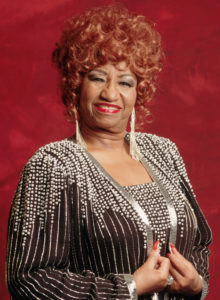“There are three kinds of people: those who care until death, working to death and those who are bored to death.” However, Winston Churchill, the mentor of the famous phrase, never met Celia Cruz, who would have shown that it is possible to enjoy life to the last straw. Furthermore, in this hypothetical limbo encounters never consummated, The Guarachera of Cuba probably would have shown that it also holds an expression as universal as the British statesman, although literally sweeter: “Sugar”.
Today, more than a decade after her death, still yearns for the singer infinitely habanera, which is a distressing sensation, as her legacy would not have been the harbinger of currently enjoying popular music not only in the Caribbean, but from the Latin whole, without that personality so typical of tropical tempero: overwhelming, impetuous, candid, dramatic and seductive. A devastating hurricane island hearts, the same as after experiencing their sound Gale discovered the joy.
https://youtu.be/8D2jQqhoKyE
Despite the joy that radiated, Celia Cruz was a survivor; previously had an appointment with one of the most agonizing ways to die: banishment. As if it were a paradox of fate, the July 15, 1960 the artist, whose passion for music was more powerful than his father’s decision that he was a school teacher, he left Cuba with La Sonora Matancera, the orchestra who shot to popularity, bound for Mexico, never imagined he would not return to his home anymore, neither to act nor much less to bury their parents. And it months before, Fidel Castro launched the Cuban Revolution, which the singer was adverse to the end of his days. The closest I could get back to his people was in the naval base at Guantanamo Bay in 1990 off the plane where he knelt and kissed the ground three times, came to the fence that divides the installation of the rest of the island, picked up a handful of soil, put it in a small bag, and, as a last wish, he asked to be discharged into his coffin.
So the maximum musical ambassador Greater Antilles, who lived mainly in the cultural obscurantism of his country, which was accepted until the eighties his exiled condition, could be heard on the radio Cuban again last year, when Raul Castro’s government lifted the ban hanging over it, like 49 other exponents.
https://youtu.be/E9iIBCO3vlE
During all those years, his countrymen never heard of the hundreds of tours around the world, it was the first Hispanic and black to appear at Carnegie Hall, in his speech in The Mambo Kings and many other films of its five Grammy, and the Guinness World Record he set in 1987 at the Carnival of Santa Cruz de Tenerife, in convening 250,000 people, in the biggest concert in an open plaza has been given in history. Or of his collaborations with artists, demonstrations despite belonging to sound so different, like Ricky Martin and Los Fabulosos Cadillacs, could not hide his admiration for her career.
LA INOLVIDABLE “REINA DE CUBA” CELIA CRUZ. IN MEMORIAM.
“Existen tres tipos de personas: aquellas que se preocupan hasta la muerte, las que trabajan hasta morir y las que se aburren hasta la muerte”. No obstante, Winston Churchill, el mentor de la célebre frase, nunca conoció a Celia Cruz, quien le hubiera demostrado que es posible disfrutar de la vida hasta el acabose. Además, en ese hipotético limbo de los encuentros nunca consumados, La Guarachera de Cuba seguramente le habría demostrado que ella también ostenta una expresión tan universal como la del estadista británico, aunque literalmente más dulce: “¡Azúcar!”.
Hoy, a mas de una década de su fallecimiento, aún se añora infinitamente a la cantante habanera, lo que es una sensación angustiosa, pues su legado no hubiera sido el heraldo del que goza actualmente la música popular ya no sólo del Caribe, sino de la América entera, sin esa personalidad tan propia del tempero tropical: avasallante, impetuosa, cándida, dramática y seductora. Un huracán devastador de corazones insulares, los mismos que luego de experimentar su vendaval sonoro descubrieron la alegría.
A pesar de la dicha que irradiaba, Celia Cruz era una superviviente, pues anteriormente tuvo una cita con una de las formas más agónicas de morir: el destierro. Como si se tratara de una paradoja del destino, el 15 de julio de 1960 la artista, cuya pasión por la música fue más poderosa que la decisión de su padre de que fuera maestra de escuela, salió de Cuba junto a La Sonora Matancera, la orquesta que la disparó hacia la popularidad, con destino a México, sin imaginarse que no regresaría nunca más a su terruño, ni para actuar ni mucho menos para enterrar a sus padres. Y es que meses antes, Fidel Castro puso en marcha la Revolución cubana, de la que la cantante fue adversaria hasta el fin de sus días. Lo más cerca que pudo volver a estar de su gente fue en la base naval de la bahía de Guantánamo, en 1990, donde al bajar del avión se arrodilló, besó tres veces el suelo, se acercó al alambrado que divide a la instalación del resto de la isla, cogió un puñado de tierra, la metió en una pequeña bolsa, y, a manera de último deseo, pidió que lo vertieran en su ataúd.
Así que la máxima embajadora musical de la mayor de las Antillas, quien vivió básicamente en el oscurantismo cultural de su país, en el que se aceptó recién en los ochenta su condición de exiliada, pudo escucharse nuevamente en las radios cubanas el año pasado, cuando el gobierno de Raúl Castro levantó el veto que pesaba sobre ella, al igual que en otros 49 exponentes.
Durante todos esos años, sus compatriotas nunca se enteraron de sus cientos de giras alrededor del mundo, de que fue la primera hispana y negra en presentarse en el Carnegie Hall, de su intervención en Los Reyes del Mambo y otras tantas películas, de sus cinco Grammy, y del Récord Guiness que estableció en 1987 en el Carnaval de Santa Cruz de Tenerife, al convocar 250.000 personas, en el mayor concierto en una plaza abierta que se haya dado en la historia. O de sus colaboraciones con artistas que, pese a pertenecer a manifestaciones sonoras tan distintas, como Ricky Martin o Los Fabulosos Cadillacs, no podían disimular su admiración hacia su trayectoria.
Agencies/ElPais/Vera Rojas/YouTube/Internet Photo/Arnoldo Varona/ TheCubanHistory.com
THE CUBAN HISTORY, HOLLYWOOD.






